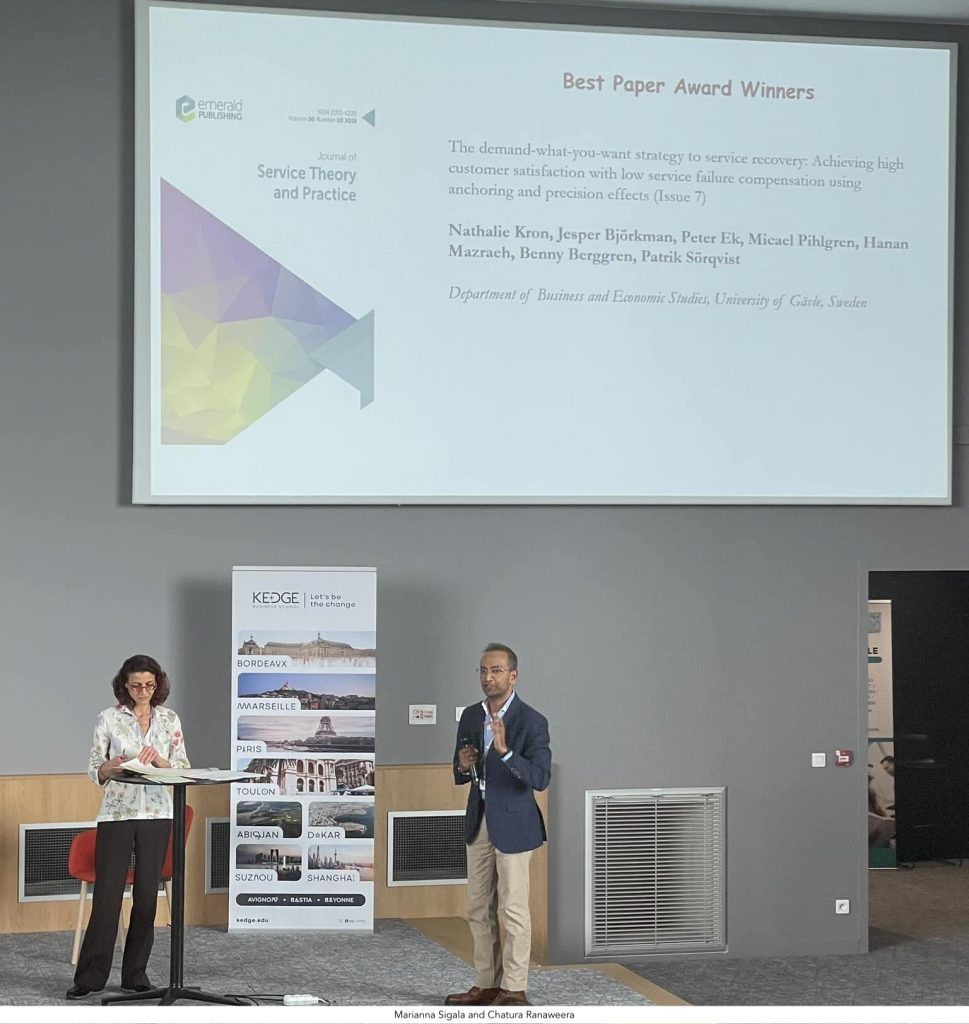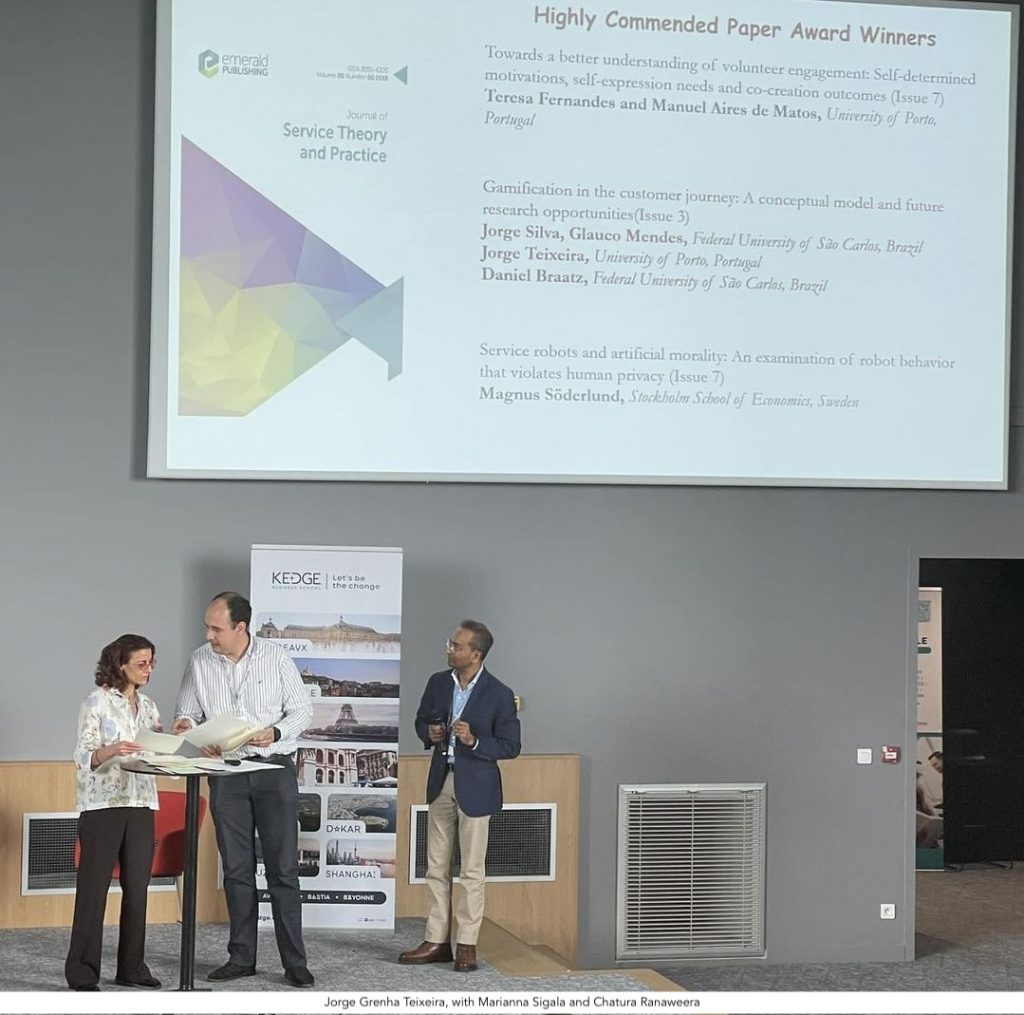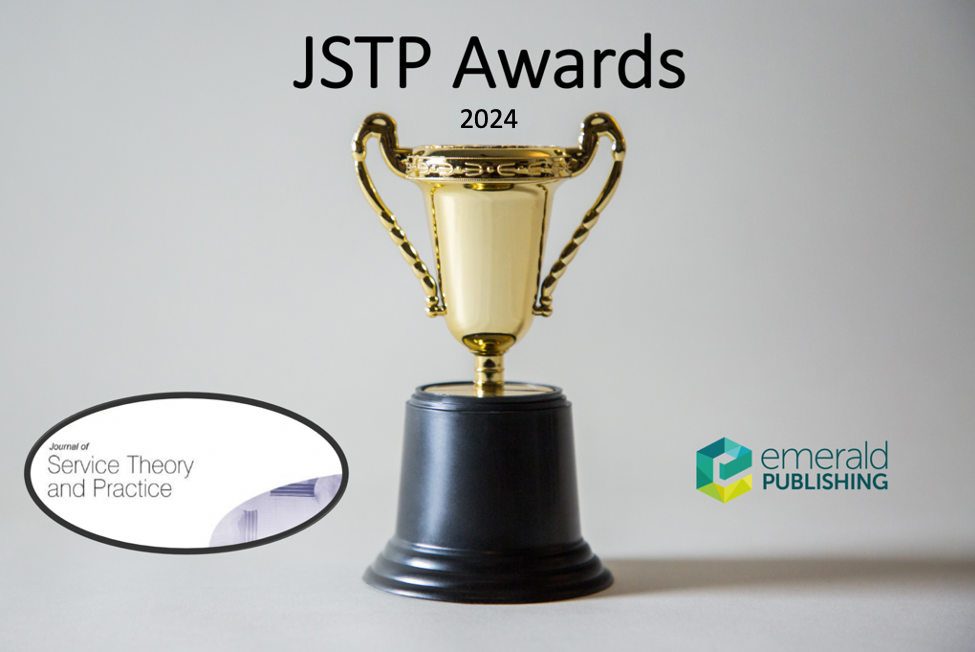At the SERVSIG 2024 Conference, Marianna Sigala and Chatura Ranaweera, co-editors of the Journal of Service Theory and Practice (JSTP) were very pleased to announce and congratulate the winners of the best paper award, and three highly commended papers, as well as the three best reviewers. We join them in congratulating the winners and recognising their contribution to the service field.
Best Paper Award

Kron N., Björkman J., Ek P., Pihlgren M., Mazrach H., Berggren B., and Sörquist P. (2023)
The demand-what-you-want strategy to service recovery: achieving high customer satisfaction with low service failure compensation using anchoring and precision effects
Previous research suggests that the compensation offered to customers after a service failure has to be substantial to make customer satisfaction surpass that of an error-free service. However, with the right service recovery strategy, it might be possible to reduce compensation size while maintaining happy customers. The aim of the current study is to test whether an anchoring technique can be used to achieve this goal.
After experiencing a service failure, participants were told that there is a standard size of the compensation for service failures. The size of this standard was different depending on condition. Thereafter, participants were asked how much they would demand to be satisfied with their customer experience.
The compensation demand was relatively high on average (1,000–1,400 SEK, ≈ $120). However, telling the participants that customers typically receive 200 SEK as compensation reduced their demand to about 800 SEK (Experiment 1)—an anchoring effect. Moreover, a precise anchoring point (a typical compensation of 247 SEK) generated a lower demand than rounded anchoring points, even when the rounded anchoring point was lower (200 SEK) than the precise counterpart (Experiment 2)—a precision effect.
Setting a low compensation standard—yet allowing customers to actually receive compensations above the standard—can make customers more satisfied while also saving resources in demand-what-you-want service recovery situations, in particular when the compensation standard is a precise value.
Highly Commendable papers

Fernandes T. and Matos MAd. (2023) Towards a better understanding of volunteer engagement: self-determined motivations, self-expression needs and co-creation outcomes
Non-profit organizations (NPO) contribute significantly to the welfare of citizens and communities. Engagement in volunteering is crucial for sustaining volunteer motivation and for the effective and efficient functioning of NPO, with significant implications for society at large. Yet, literature on volunteer engagement (VE) is limited to date. Grounded on service-dominant logic, self-congruity theory and self-determination theory, this study aims to understand what motivates VE and how it may evolve into a co-creation process valuable to NPO and its stakeholders.
Based on survey data collected from 450 volunteers, working with a diverse set of NPO, a comprehensive model of drivers and outcomes of VE was empirically tested using PLS-SEM, considering the mediating role of volunteers’ congruence with the core values of the NPO.
The impact of volunteers’ perceived autonomy, competence and relatedness on VE and its subsequent role in volunteers’ loyalty and extra-role engagement behaviors (i.e. co-development, influencing and mobilizing behaviors) were validated. Moreover, the study validates value congruence as an internalizing mediating mechanism in the engagement process, a role that has been implied but not empirically tested.
The study contributes to the engagement and volunteering literature, which despite an unprecedented parallel have developed almost independently, with limited reference to one another. As the nomological network of VE is still underexplored, the study extends the engagement literature to the volunteering sector, validating the key (but underexplored) role of self-determination needs and value congruence in driving VE and value co-creation behaviors. The study further adds to engagement research while addressing other actors’ engagement beyond the customer–brand dyad. While adopting a seldom explored marketing perspective of VE, this study provides NPO valuable insights on how to manage and engage volunteers.
Silva J.H.O., Mendes G.H.S, Teixeira J.G., and Braatz D. (2023) Gamification in the customer journey: a conceptual model and future research opportunities
While academics and practitioners increasingly recognize the impacts of gamification on customer experience (CX), its role in the customer journey remains undeveloped. This article aims to identify how gamification can leverage each customer journey stage, integrate the findings into a conceptual model and propose future research opportunities.
Since CX and customer journey are interrelated concepts, the authors rely on CX research to identify research themes that provide insights to propose the conceptual model. A systematic review of 154 articles on the interplay between gamification and CX research published from 2013 to 2022 was performed and analyzed by thematic content analysis. The authors interpreted the results according to the service customer journey stages and the taxonomy of digital engagement practices.
This article identified five main thematic categories that shape the conceptual model (design, customer journey stages, customer, technology and context). Gamification design can support customer value creation at any customer journey stage. While gamification can leverage brand engagement at the pre-service stage by enhancing customer motivation and information search, it can leverage service and brand engagement at the core and post-service stages by enhancing customer participation and brand relationships. Moreover, customer-, technology- and context-related factors influence the gamified service experience in the customer journey.
This article contributes to a conceptual integration between gamification and customer journey. Additionally, it provides opportunities for future research from a customer journey perspective.
Söderlund M. (2023) Service robots and artificial morality: an examination of robot behavior that violates human privacy
Service robots are expected to become increasingly common, but the ways in which they can move around in an environment with humans, collect and store data about humans and share such data produce a potential for privacy violations. In human-to-human contexts, such violations are transgression of norms to which humans typically react negatively. This study examines if similar reactions occur when the transgressor is a robot. The main dependent variable was the overall evaluation of the robot.
Service robot privacy violations were manipulated in a between-subjects experiment in which a human user interacted with an embodied humanoid robot in an office environment.
The results show that the robot’s violations of human privacy attenuated the overall evaluation of the robot and that this effect was sequentially mediated by perceived robot morality and perceived robot humanness. Given that a similar reaction pattern would be expected when humans violate other humans’ privacy, the present study offers evidence in support of the notion that humanlike non-humans can elicit responses similar to those elicited by real humans.
The results imply that designers of service robots and managers in firms using such robots for providing service to employees should be concerned with restricting the potential for robots’ privacy violation activities if the goal is to increase the acceptance of service robots in the habitat of humans.
To date, few empirical studies have examined reactions to service robots that violate privacy norms.
Best Reviewers

Achilleas Boukis, University of Birmingham, UK
Mekhail Mustak, IESEG Business School, France
Sven Tuzovic, Queensland University of Technology, Australia
Previous JSTP Awards
– 2016
– 2017
– 2018
– 2019
– 2020
– 2023


